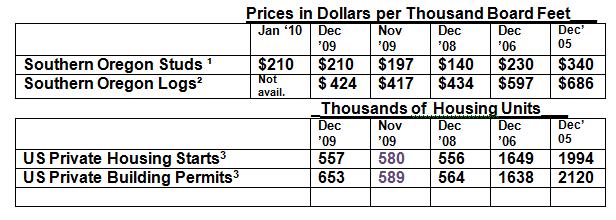By Rick sohn
Umpqua Coquille LLC
Building Permits were up and logs were more affordable for mills, last month. However, unsold inventories and interest rates also went up, and housing starts were down. See four-year price tracking and discussion of lumber, logs, housing starts and permits, unsold home inventory, and mortgage rates below.
What the numbers mean.
There is positive news this month, in Building Permits, up almost 11%, since November. The building permits predict housing starts 1-3 months before construction begins. This is the right direction, but a slow pace, even at an 11% increase. Housing starts were down 4% seasonally adjusted, but the next few months should make it up.
While the inventory of unsold homes has, unfortunately, risen again in Portland, Oregon, RMLS reports that the average price of the homes that sold in Portland is up 7.3%. This is not an “apples to apples” comparison. This increase appears to actually be caused by the sale of more, larger homes (or maybe fewer low-priced auction homes), rather than an increase in home value. The average sales price rose $20,000 from November to December while the median sales price rose only $3,000 in the same period.**
A more accurate, albeit more dated, read on home price increases comes from the Case-Schiller Index, which is also tricky. It is reported to be up 0.9% in Portland from October to November (the most recent data available), but this is a seasonally adjusted number. The actual increase (not seasonally adjusted) was only 0.3% (3/10 of one percent) in Portland. Is a 3-times greater seasonal adjustment justified, especially in this economy? A 0.2% increase is reported for a national composite of 20 cities, seasonally adjusted, while the non-adjusted figure is a LOSS of 0.2% nationally from October to November. Thus, the actual numbers may not be as pretty as has been reported in some media.
While mills are struggling and in the Red, with low product costs, high fixed costs, and low volumes, logs were more affordable, last month. Lumber and logs are approaching the price ratio of 2005. While both lumber and log prices have come up from their lows, lumber prices have risen faster, which is good for the mills. See the chart below. Usually, log prices are slower to adjust than product prices, and this market cycle is no exception.
**(For more information on averages, medians, and other statistics , see How to Lie with Statistics, an easy-to-read 1954 Classic, http://www.jimloy.com/books/howtolie.htm,
Data reports used with permission of:
1) Random Lengths. 2”x4”x8’ precision end trimmed hem-fir studs from southern Oregon mills. Price reported is Dollars per Thousand Board Feet for the most recent week. One “board foot” of product measures 12 inches by 12 inches by one inch thick.
2) RISI, Log Lines. Douglas-fir #2 Sawmill Log Average Region 5 price. Current report is for the prior month. Dollars per Thousand Board Feet of logs are reported using standardized log measurements from the “Scribner log table.”
3) Dept. of Commerce, US Census Bureau. New Residential Housing Starts and New Residential Construction Permits, annually adjusted. Current report is for the prior month. Recent reports are often revised in bold from the prior month.
4) Regional Multiple Listing Service RMLSTM data, courtesy of Janet Johnston, Prudential Real Estate Professionals Broker, Roseburg, OR. Inventory of Unsold Homes (Ratio of Active Listings to Closed Sales) in Portland Oregon, for most recent month available.
5) Freddie Mac. Primary Mortgage Market Survey. 30-year Fixed Rate Mortgages Since 1971, national averages. Updated weekly, current report is for the prior full month.
© Copyright Rick Sohn, #3-1 Umpqua Coquille LLC. Email [email protected]
Disclaimer: Articles featured on Oregon Report are the creation, responsibility and opinion of the authoring individual or organization which is featured at the top of every article.




